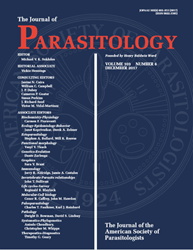Tapeworm Diversity Continues to Expand
 Journal of Parasitology - The discovery of a new species helps explain the biodiversity on Earth and what function each species plays. Even small organisms, such as parasites, can play critical roles in ecosystem networks. A recent study in the current issue of the Journal of Parasitology expands our knowledge about the diversity of tapeworms in marine animals and how connected parasite and host truly are.
Journal of Parasitology - The discovery of a new species helps explain the biodiversity on Earth and what function each species plays. Even small organisms, such as parasites, can play critical roles in ecosystem networks. A recent study in the current issue of the Journal of Parasitology expands our knowledge about the diversity of tapeworms in marine animals and how connected parasite and host truly are.
While working near Darwin, Australia, researchers from the University of Connecticut and Martha's Vineyard High School encountered sawfish (Pristis clavata) that were parasitized by unique tapeworms. The researchers collected several of these tapeworms, studied and carefully detailed their physical characteristics, and sequenced their DNA to determine whether they were similar to known species. After comparing the DNA, the researchers formally identified a new genus of tapeworm.
A quarter of all known tapeworms of elasmobranchs (sharks, rays, sawfish) have been discovered in the past couple decades. This shows that there is a huge diversity of these parasites and likely more remain undiscovered. The researchers' findings further expanded the knowledge about the diversity of tapeworms that parasitize this group of fish.
The newly classified tapeworms are distinctive because of their physical characteristics, including the presence of bipronged hooks and a tiny body size. Molecular analysis revealed that the DNA of these tapeworms is similar to other parasites of elasmobranchs. Thus, they determined that these tapeworms comprise two species in a new genus that they named Matticestus.
Matticestus tapeworms exclusively parasitize Pristis clavata sawfish. This tapeworm's narrow niche may be a problem when considering efforts to conserve the biodiversity on Earth. "The freshwater-tolerant sawfish is at present considered endangered by the International Union for Conservation of Nature," said author J. N. Caira. Therefore, if these sawfish become extinct, their parasites may as well, which illustrates the interconnectedness of organisms.
The authors predict that there are likely more undiscovered tapeworms that belong to this new genus and that there are many unanswered questions about this group, including whether the larval stage infects intermediate hosts. The detailed description of this new genus of tapeworm aids our understanding of the overall biodiversity of tapeworms that parasitize elasmobranchs. Future work will use these descriptions and DNA sequences to continue working on revealing the biodiversity of tapeworms.
Full text of the article "A New Genus of Tapeworm (Cestoda: Onchoproteocephalidea) from Sawfish (Elasmobranchii: Pristidae)," Journal of Parasitology, Vol 104, No. 2, 2018, is available at http://www.journalofparasitology.org/doi/abs/10.1645/17-165.
About the Journal of Parasitology
The Journal of Parasitology is the official journal of the American Society of Parasitologists (ASP). It is a medium for the publication of new original research, primarily on parasitic animals, and official business of the ASP. The journal is intended for all with interests in basic or applied aspects of general, veterinary, and medical parasitology and epidemiology. For more about the journal or the society, see http://www.journalofparasitology.org.
Comments
Videos

